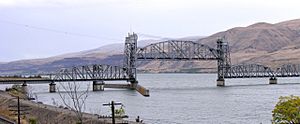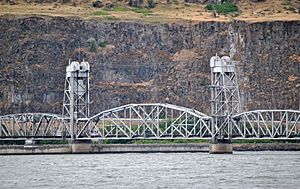Oregon Trunk Rail Bridge facts for kids
Quick facts for kids Oregon Trunk Bridge |
|
|---|---|

Viewed from the southwest
|
|
| Coordinates | 45°38′56.2″N 120°58′54.3″W / 45.648944°N 120.981750°W |
| Carries | 1 railroad track of BNSF Railway |
| Crosses | Columbia River |
| Locale | Oregon Trunk Junction, Oregon (in Wasco County); Wishram, Washington |
| Characteristics | |
| Design | Pratt truss with swing span (inoperable) and vertical-lift span (operational) |
| Total length | approx. 2,400–3,350 feet |
| Longest span | approx. 300 feet |
| History | |
| Opened | January 1912 |
The Oregon Trunk Rail Bridge, also called the Celilo Bridge, is a railroad bridge that opened in 1912. It crosses the Columbia River in the Pacific Northwest of the United States. This bridge carries a single train track.
The bridge is made of eight steel truss sections and other support beams. A truss is a strong framework of connected triangles. Since 1957, it has also included a special vertical-lift section. A famous engineer named Ralph Modjeski designed the bridge. It was built by the Missouri Valley Bridge & Iron Co.
About the Bridge
This bridge is an important part of the train line that runs from Wishram, Washington to Bend, Oregon. This line is used by the BNSF Railway, which is a big train company. Before, it was part of the Oregon Trunk line.
The bridge is located downstream from where Celilo Falls used to be. These falls are now covered by water because of The Dalles Dam. There used to be a waterway called the Celilo Canal under the bridge. The southernmost part of the bridge was a swing span, which could swing open for boats.
How the Dam Changed the Bridge
When The Dalles Dam was finished in 1957, it caused the water level in the river to rise. This meant the Celilo Canal was covered by water. To make sure trains could still use the bridge, it had to be changed.
Starting in October 1956, the bridge was lifted by about 5 feet (1.5 meters) along its entire length. The section next to the old swing span was changed into a vertical-lift span. This new lift span could be raised to let taller boats pass underneath.
The new lift span was first fully raised and lowered on June 21, 1957. The bridge then reopened for trains the very next day. The old swing span is still there, but it is no longer used. It was permanently locked in place in October 1956 when work began to change the bridge.

Bridge Foundations and Length
All of the bridge's supports, called piers, rest on rocks. These rocks were usually visible when the river water was low. The builders had to construct the piers during these low-water times. This part of the Columbia River could have very strong rapids when the water was high.
The north end of the bridge has a "wye" shape. This is where the train line from Bend connects with the main BNSF line that goes from Portland to Pasco. On the south end, the line crosses over and connects with the Union Pacific train line.
The main part of the bridge, not counting the two branches at the north end, is about 2,396 feet (730 meters) long. The east branch of the wye is 952 feet (290 meters) long, and the west branch is 849 feet (259 meters) long.
When the bridge was first built, its longest single section was a 316-foot (96-meter) fixed span. This section was located just north of the swing span. Later, this long fixed section was replaced by the lift span we see today.


